Citroen C3 2014 2.G Repair Manual
Manufacturer: CITROEN, Model Year: 2014, Model line: C3, Model: Citroen C3 2014 2.GPages: 284, PDF Size: 9.01 MB
Page 61 of 284
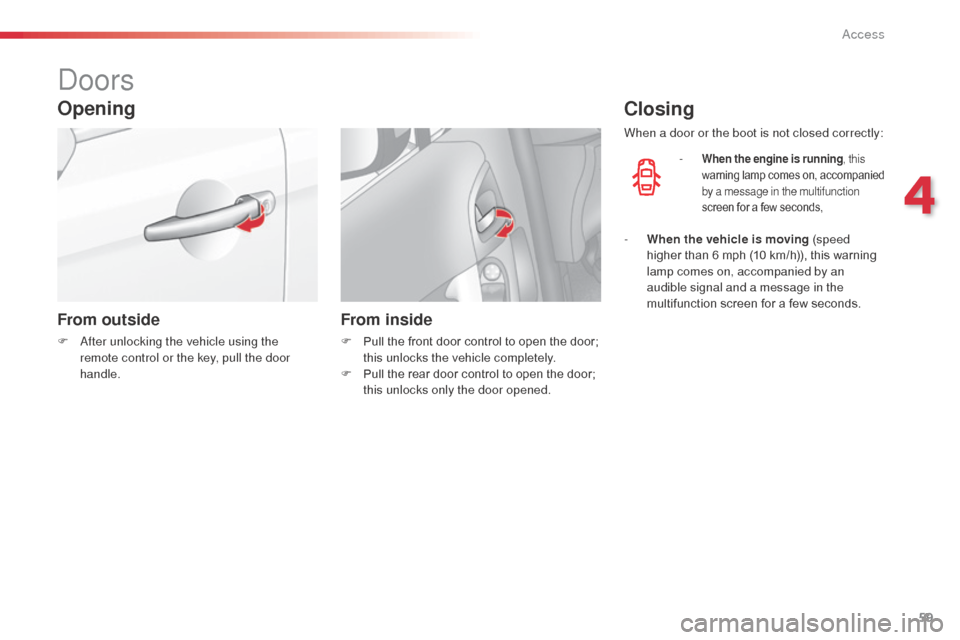
59
C3_en_Chap04_ouvertures_ed01-2014
doors
Opening
From outside
F after unlocking the vehicle using the
remote control or the key, pull the door
handle.
From inside
F Pull the front door control to open the door; this unlocks the vehicle completely.
F
P
ull the rear door control to open the door;
this unlocks only the door opened.
Closing
- When the engine is running , this
warning lamp comes on, accompanied
by a message in the multifunction
screen for a few seconds,
When a door or the boot is not closed correctly:
-
W
hen the vehicle is moving (speed
higher than 6 mph (10 km/h)), this warning
lamp comes on, accompanied by an
audible signal and a message in the
multifunction screen for a few seconds.
4
access
Page 62 of 284
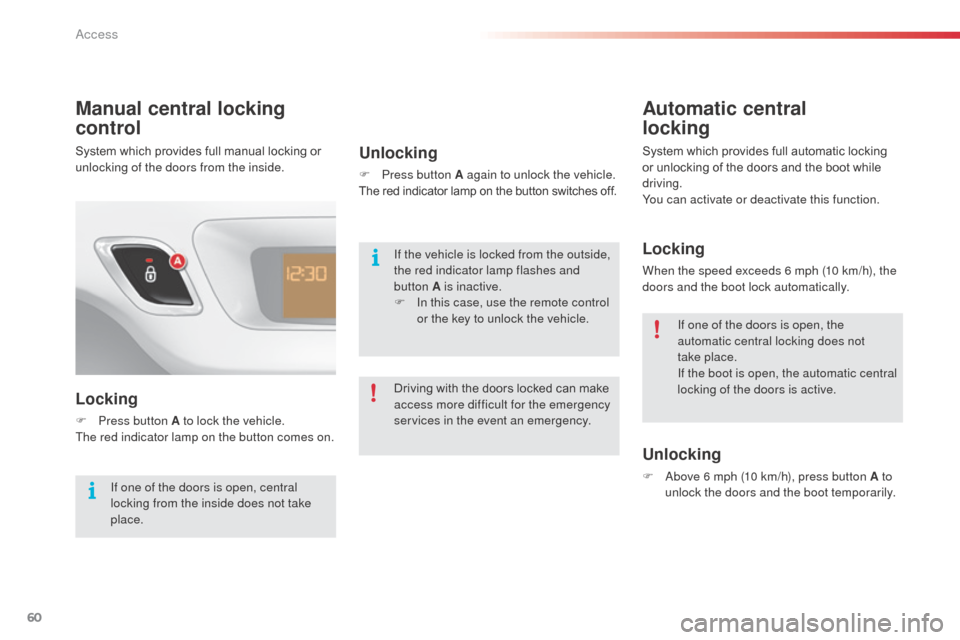
60
C3_en_Chap04_ouvertures_ed01-2014
Manual central locking
control
Locking
F Press button A to lock the vehicle.
The red indicator lamp on the button comes on.
Unlocking
F Press button A again to unlock the vehicle.
The red indicator lamp on the button switches
off.
Automatic central
locking
Locking
When the speed exceeds 6 mph (10 km/h), the
doors and the boot lock automatically.
Unlocking
F above 6 mph (10 km/h), press button A to unlock the doors and the boot temporarily.
If the vehicle is locked from the outside,
the red indicator lamp flashes and
button A is inactive.
F
I
n this case, use the remote control
or the key to unlock the vehicle. If one of the doors is open, the
automatic central locking does not
take place.
If the boot is open, the automatic central
locking of the doors is active.
If one of the doors is open, central
locking from the inside does not take
place.
System which provides full manual locking or
unlocking of the doors from the inside.
System which provides full automatic locking
or unlocking of the doors and the boot while
driving.
You can activate or deactivate this function.
Driving with the doors locked can make
access more difficult for the emergency
services in the event an emergency.
access
Page 63 of 284
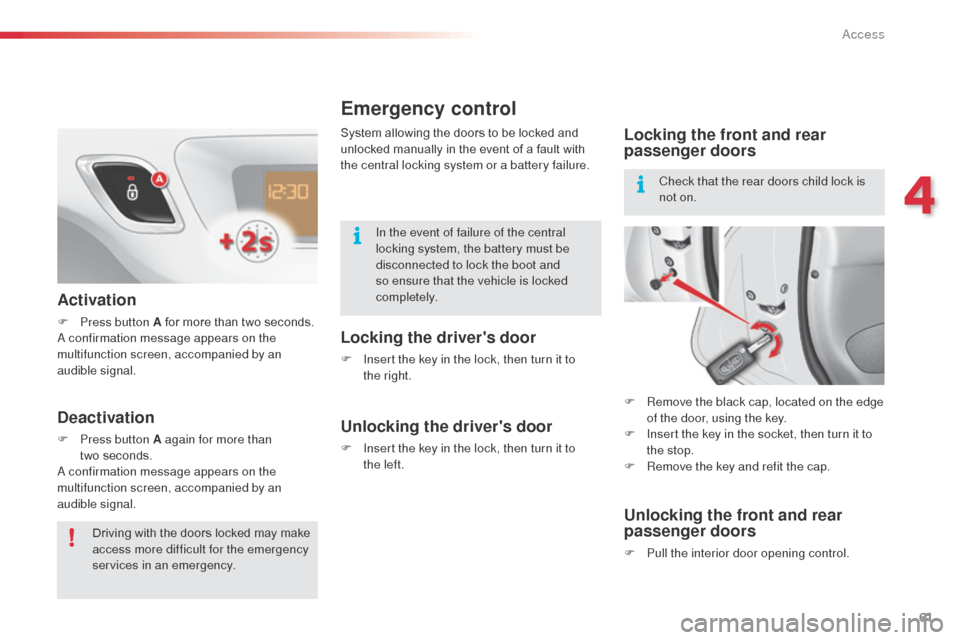
61
C3_en_Chap04_ouvertures_ed01-2014
Emergency control
Locking the driver's door
F Insert the key in the lock, then turn it to
the right.
Unlocking the driver's door
F Insert the key in the lock, then turn it to the left.
Locking the front and rear
passenger doors
F Remove the black cap, located on the edge of the door, using the key.
F
I
nsert the key in the socket, then turn it to
the stop.
F
R
emove the key and refit the cap.
Unlocking the front and rear
passenger doors
F Pull the interior door opening control.
In the event of failure of the central
locking system, the battery must be
disconnected to lock the boot and
so ensure that the vehicle is locked
completely.
Check that the rear doors child lock is
not on.
System allowing the doors to be locked and
unlocked manually in the event of a fault with
the central locking system or a battery failure.
Activation
F Press button A for more than two seconds.a
confirmation message appears on the
multifunction screen, accompanied by an
audible signal.
Deactivation
F Press button A again for more than two seconds.
a
confirmation message appears on the
multifunction screen, accompanied by an
audible signal.
Driving with the doors locked may make
access more difficult for the emergency
services in an emergency.
4
access
Page 64 of 284
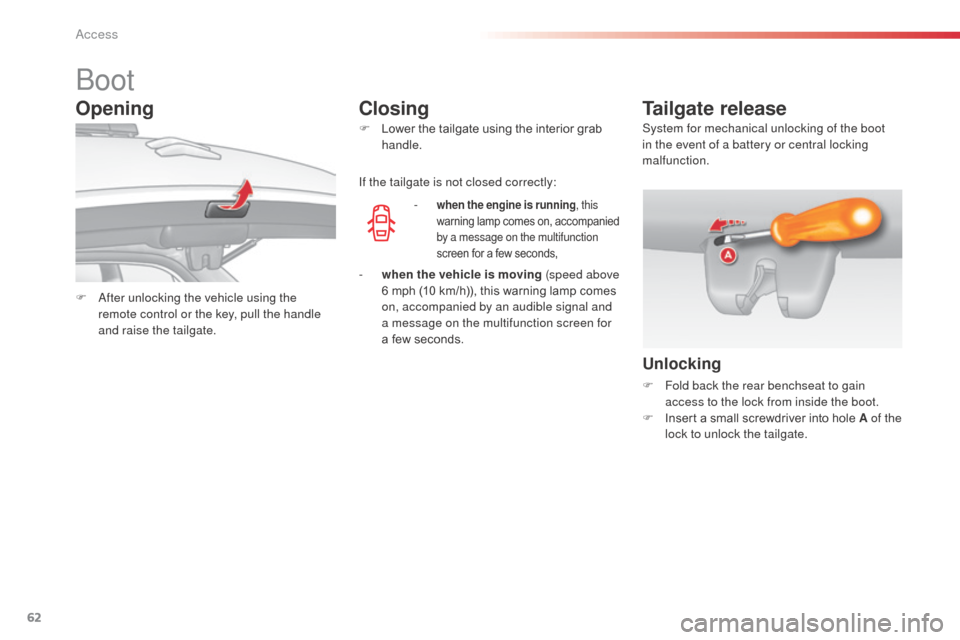
62
C3_en_Chap04_ouvertures_ed01-2014
boot
F after unlocking the vehicle using the
remote control or the key, pull the handle
and raise the tailgate. F
L
ower the tailgate using the interior grab
handle.
-
when the engine is running
, this
warning lamp comes on, accompanied
by a message on the multifunction
screen for a few seconds,
Tailgate release
Unlocking
F Fold back the rear benchseat to gain access to the lock from inside the boot.
F
I
nsert a small screwdriver into hole A of the
lock to unlock the tailgate.
If the tailgate is not closed correctly:
Opening
Closing
- when the vehicle is moving (speed above
6 mph (10 km/h)), this warning lamp comes
on, accompanied by an audible signal and
a message on the multifunction screen for
a few seconds. System for mechanical unlocking of the boot
in the event of a battery or central locking
malfunction.
access
Page 65 of 284
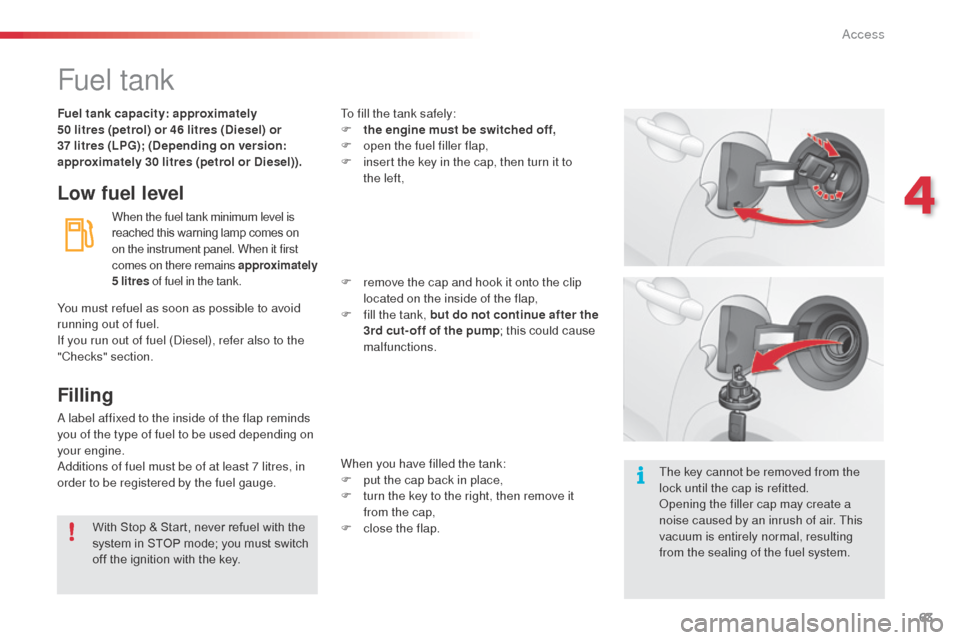
63
C3_en_Chap04_ouvertures_ed01-2014
Fuel tank
Low fuel level
When the fuel tank minimum level is
reached this warning lamp comes on
on the instrument panel. When it first
comes on there remains approximately
5 litres of fuel in the tank.
Filling
a label affixed to the inside of the flap reminds
y ou of the type of fuel to be used depending on
your engine.
ad
ditions of fuel must be of at least 7 litres, in
order to be registered by the fuel gauge. To fill the tank safely:
F
t
he engine must be switched off,
F
o
pen the fuel filler flap,
F
i
nsert the key in the cap, then turn it to
the left,
F
r
emove the cap and hook it onto the clip
located on the inside of the flap,
F
f
ill the tank, but do not continue after the
3rd cut- off of the pump ; this could cause
malfunctions.
When you have filled the tank:
F
p
ut the cap back in place,
F
t
urn the key to the right, then remove it
from the cap,
F
c
lose the flap.
You must refuel as soon as possible to avoid
running out of fuel.
If you run out of fuel (
di
esel), refer also to the
"Checks" section. Fuel tank capacity: approximately
50 litres (petrol) or 46 litres (Diesel) or
37
litres (LPG); (Depending on version:
approximately 30 litres (petrol or Diesel)).
With Stop & Start, never refuel with the
system in STOP mode; you must switch
off the ignition with the key. The key cannot be removed from the
lock until the cap is refitted.
op
ening the filler cap may create a
noise caused by an inrush of air. This
vacuum is entirely normal, resulting
from the sealing of the fuel system.
4
access
Page 66 of 284
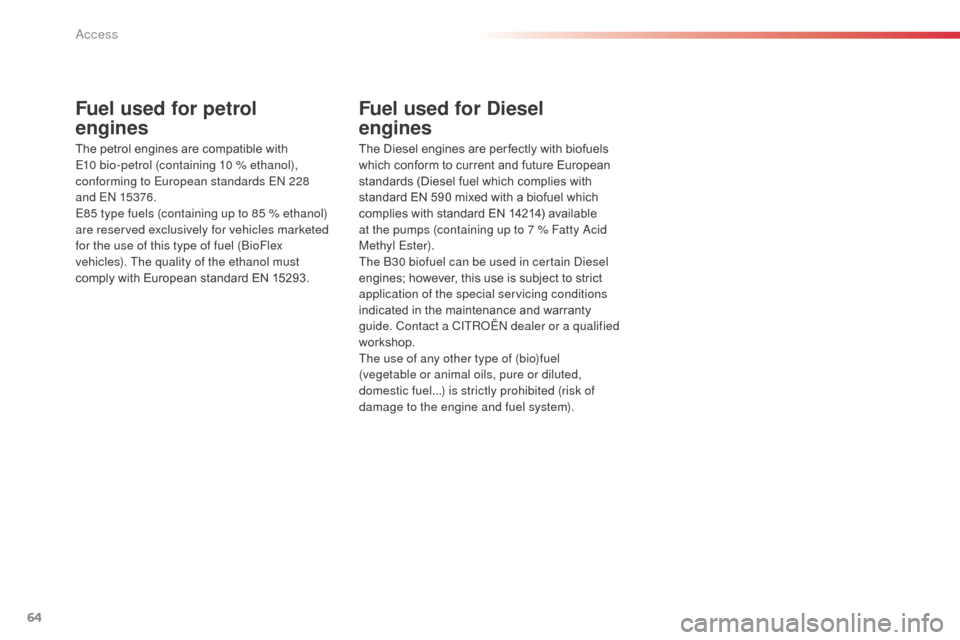
64
C3_en_Chap04_ouvertures_ed01-2014
Fuel used for petrol
engines
The petrol engines are compatible with
E10 bio-petrol (containing 10 % ethanol),
conforming to European standards E
n
228
and E
n 1
5376.
E85 type fuels (containing up to 85 % ethanol)
are reserved exclusively for vehicles marketed
for the use of this type of fuel (
bi
oFlex
vehicles). The quality of the ethanol must
comply with European standard EN 15293.
Fuel used for Diesel
engines
The Diesel engines are per fectly with biofuels
which conform to current and future European
standards (Diesel fuel which complies with
standard EN 590 mixed with a biofuel which
complies with standard EN 14214) available
at the pumps (containing up to 7 % Fatty
a
c
id
Methyl Ester).
The
b
3
0 biofuel can be used in certain d
i
esel
engines; however, this use is subject to strict
application of the special servicing conditions
indicated in the maintenance and warranty
guide. Contact a CITR
oËn
dealer or a qualified
workshop.
The use of any other type of (bio)fuel
(vegetable or animal oils, pure or diluted,
domestic fuel...) is strictly prohibited (risk of
damage to the engine and fuel system).
access
Page 67 of 284
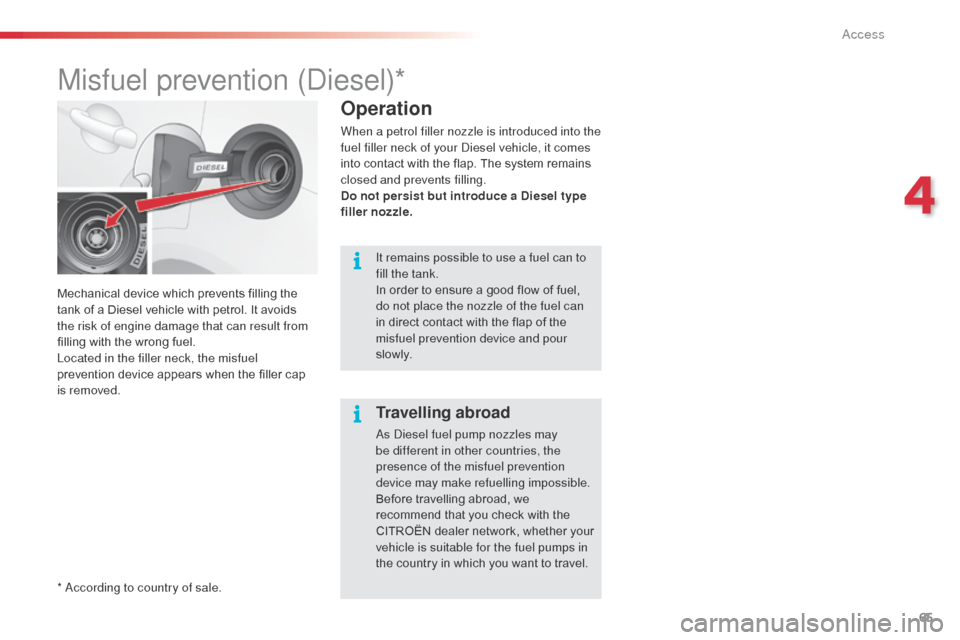
65
C3_en_Chap04_ouvertures_ed01-2014
Mechanical device which prevents filling the
tank of a Diesel vehicle with petrol. It avoids
the risk of engine damage that can result from
filling with the wrong fuel.
Located in the filler neck, the misfuel
prevention device appears when the filler cap
is removed.
Misfuel prevention (die sel)*
Operation
When a petrol filler nozzle is introduced into the
fuel filler neck of your
di esel vehicle, it comes
into contact with the flap. The system remains
closed and prevents filling.
Do not persist but introduce a Diesel type
filler nozzle.
*
a
c
cording to country of sale. It remains possible to use a fuel can to
fill the tank.
In order to ensure a good flow of fuel,
do not place the nozzle of the fuel can
in direct contact with the flap of the
misfuel prevention device and pour
s l ow l y.
Travelling abroad
as
diesel fuel pump nozzles may
be different in other countries, the
presence of the misfuel prevention
device may make refuelling impossible.
Before travelling abroad, we
recommend that you check with the
CITROËN dealer network, whether your
vehicle is suitable for the fuel pumps in
the country in which you want to travel.
4
access
Page 68 of 284
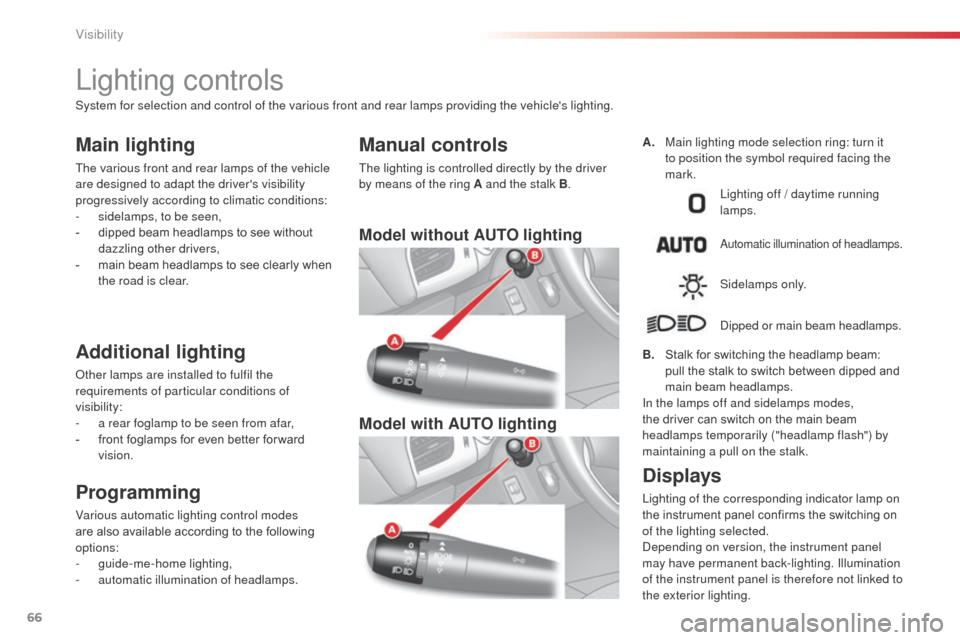
66
C3_en_Chap05_Visibilite_ed01-2014
Lighting controls
Main lighting
The various front and rear lamps of the vehicle
are designed to adapt the driver's visibility
progressively according to climatic conditions:
-
s
idelamps, to be seen,
-
d
ipped beam headlamps to see without
dazzling other drivers,
-
m
ain beam headlamps to see clearly when
the road is clear.
Additional lighting
other lamps are installed to fulfil the
requirements of particular conditions of
visibility:
-
a r
ear foglamp to be seen from afar,
-
f
ront foglamps for even better for ward
vision.
Programming
Various automatic lighting control modes
are also available according to the following
options:
-
gu
ide-me-home lighting,
-
a
utomatic illumination of headlamps.
Model without AUTO lighting
Model with AUTO lighting
Lighting off / daytime running
lam ps.
automatic illumination of headlamps.
Sidelamps only.
dip
ped or main beam headlamps.
B.
S
talk for switching the headlamp beam:
pull the stalk to switch between dipped and
main beam headlamps.
In the lamps off and sidelamps modes,
the
driver can switch on the main beam
headlamps temporarily ("headlamp flash") by
maintaining a pull on the stalk.
Displays
Lighting of the corresponding indicator lamp on
the instrument panel confirms the switching on
of the lighting selected.
dep
ending on version, the instrument panel
may have permanent back-lighting. Illumination
of the instrument panel is therefore not linked to
the exterior lighting.
Manual controls
The lighting is controlled directly by the driver
by means of the ring A and the stalk B .A.
M
ain lighting mode selection ring: turn it
to position the symbol required facing the
mark.
System for selection and control of the various front and rear lamps providing the vehicle's lighting.
Visibility
Page 69 of 284
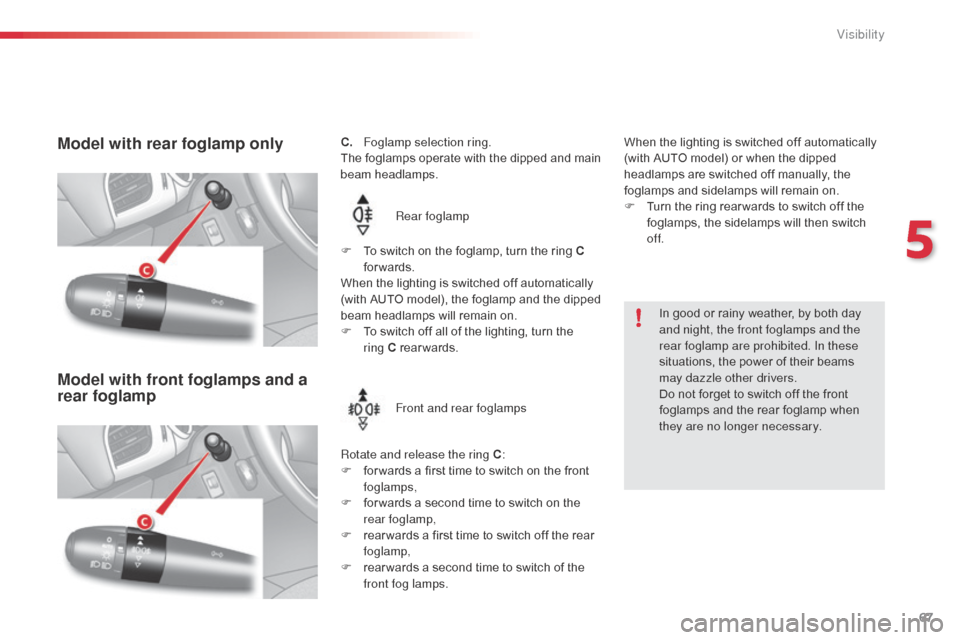
67
C3_en_Chap05_Visibilite_ed01-2014
C. Foglamp selection ring.
The foglamps operate with the dipped and main
beam headlamps.Rear foglamp
Rotate and release the ring C :
F
f
or wards a first time to switch on the front
foglamps,
F
f
or wards a second time to switch on the
rear foglamp,
F
r
ear wards a first time to switch off the rear
foglamp,
F
r
ear wards a second time to switch of the
front fog lamps.Model with rear foglamp only
F To switch on the foglamp, turn the ring C forwards.
When the lighting is switched off automatically
(with AUTO model), the foglamp and the dipped
beam headlamps will remain on.
F
T
o switch off all of the lighting, turn the
ring
C rearwards.
Model with front foglamps and a
rear foglamp
Front and rear foglamps When the lighting is switched off automatically
(with AUTO model) or when the dipped
headlamps are switched off manually, the
foglamps and sidelamps will remain on.
F
T
urn the ring rear wards to switch off the
foglamps, the sidelamps will then switch
of f.
In good or rainy weather, by both day
and night, the front foglamps and the
rear foglamp are prohibited. In these
situations, the power of their beams
may dazzle other drivers.
Do not forget to switch off the front
foglamps and the rear foglamp when
they are no longer necessary.
5
Visibility
Page 70 of 284
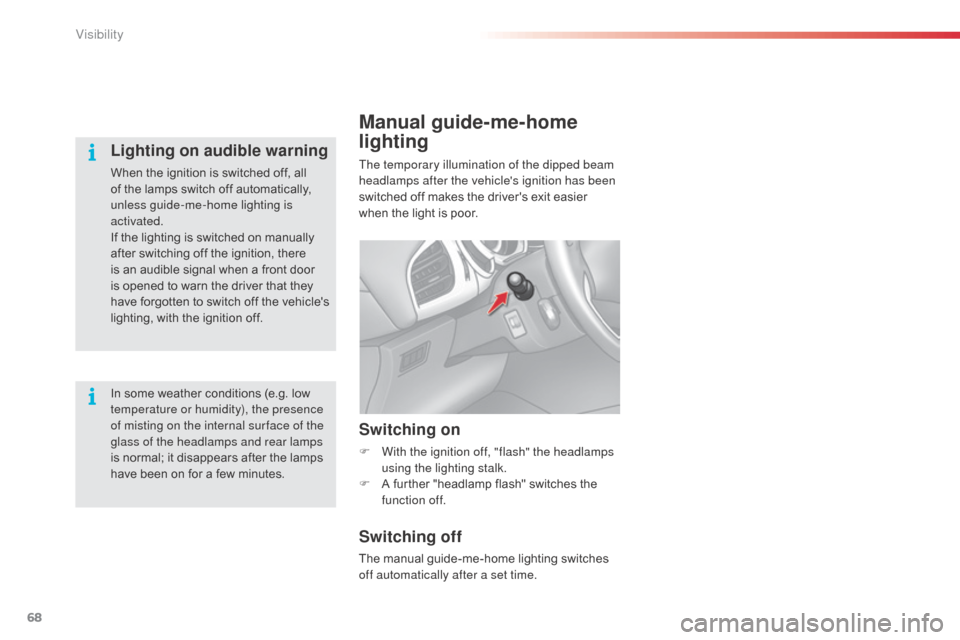
68
C3_en_Chap05_Visibilite_ed01-2014
Manual guide-me-home
lighting
The temporary illumination of the dipped beam
headlamps after the vehicle's ignition has been
switched off makes the driver's exit easier
when the light is poor.
Switching on
F With the ignition off, "flash" the headlamps using the lighting stalk.
F
A f
urther "headlamp flash" switches the
function off.
Switching off
The manual guide-me-home lighting switches
off automatically after a set time.
In some weather conditions (e.g. low
temperature or humidity), the presence
of misting on the internal sur face of the
glass of the headlamps and rear lamps
is normal; it disappears after the lamps
have been on for a few minutes.
Lighting on audible warning
When the ignition is switched off, all
of the lamps switch off automatically,
unless guide-me-home lighting is
activated.
If the lighting is switched on manually
after switching off the ignition, there
is an audible signal when a front door
is opened to warn the driver that they
have forgotten to switch off the vehicle's
lighting, with the ignition off.
Visibility